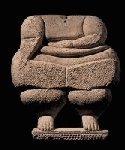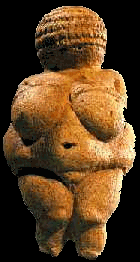

STONE AGE
BUILDING INDEX
STONE AGE
BUILDING
STANDING
STONES
NEWGRANGE
STONEHENGE
MALTA'S
MEGALITHIC
MARVELS
introduction
timeline
temple sites
ggantjia
hager qim
mnajdra
hypogeum
tarxien
magna mater
magna mater-myth
gallery
SKARA BRAE
HUNEBEDDEN
Magna Mater
The Mother Goddess
 At the temple complexes on Malta and Gozo many statuettes were found of a big fat lady, the so called Magna Mater or 'Great Mother'. Because of these statuettes we think that the temples were places of worship for the Great Mother: de oldest divinity on earth.
At the temple complexes on Malta and Gozo many statuettes were found of a big fat lady, the so called Magna Mater or 'Great Mother'. Because of these statuettes we think that the temples were places of worship for the Great Mother: de oldest divinity on earth.
What do we know about this religion?
Well, let's see... there have been cults around goddesses for millenia. The Maltese Magna Mater seems just another variation on the topic.
The ancient goddess cult predates God by tens of thousands of years, and despite millennia of fanatical repression, she still has believers and her cult is not yet ended as the (new?) Gaia cult is based upon the same principle: worshipping the Earth as the mother of all things, respecting her for giving life and taking care of her. It's obvious humanity is not massive into this religion at this time: Mother Earth is more like being raped than taken care of, these days... :(
 The earliest goddesses inspired the first art ever made as we can see by the many statuettes found on Malta, as well as throughout Europe and the Middle East. As early as 35,000 BCE, our paleolithic ancestors were making “Venuses” such as those found at Willendorf in Austria and Laussel in France. They predate the famous animal cave paintings at Lascaux and other sites by as much as 20,000 years.
The earliest goddesses inspired the first art ever made as we can see by the many statuettes found on Malta, as well as throughout Europe and the Middle East. As early as 35,000 BCE, our paleolithic ancestors were making “Venuses” such as those found at Willendorf in Austria and Laussel in France. They predate the famous animal cave paintings at Lascaux and other sites by as much as 20,000 years.
These prehistoric manifestations of the Great Goddess form the bedrock upon which all her later images and personae were built over the succeeding millennia. Before conversing with the more sophisticated goddesses of 'higher' civilizations, we must honor the Primordial Mothers of Prehistory for they are pure in their elemental feminine power.
They are to humanity what the mother is to the infant: namely, the World. When we are centered in their essence, they empower us in a deep, quiet, abiding way to be whole human beings, to be fully female, to be in harmony with the cosmos, and quite simply, to be. The fatness of the Magna Mater clearly indicates she is a fertility goddess, representing the earth in all her being.
The oldest statuette is found at Skorba. She is smaller and less fat then the later productions, one can clearly see an evolution in the form of the Magna Mater statuettes.
 Marija Gimbutas is scolar on ancient religions; in her book 'The Civilization of the Goddess' she tells of an ancient civilization dating back to 5000 BCE which she terms 'Old Europe'. Her studies offer us an interesting perspective on the development of religion and civilization. "A study of symbols in Neolithic art demonstrates that the female, rather than the male, was the deity of creation. In fact, there are no traces in Neolithic art of a father figure. Old Europe was governed communally and was "guided by a queen-priestess, her brother or uncle, and a council of women as the governing body." Gimbutas claims that, despite this guiding force of women councils, Old Europe had no inferiority between the sexes. She does not claim that Old Europe was ruled by a matriarchy, but that it was matrifocal. This civilization reflected a long tradition of agriculturally based societies that were harmonious and artistic.
Marija Gimbutas is scolar on ancient religions; in her book 'The Civilization of the Goddess' she tells of an ancient civilization dating back to 5000 BCE which she terms 'Old Europe'. Her studies offer us an interesting perspective on the development of religion and civilization. "A study of symbols in Neolithic art demonstrates that the female, rather than the male, was the deity of creation. In fact, there are no traces in Neolithic art of a father figure. Old Europe was governed communally and was "guided by a queen-priestess, her brother or uncle, and a council of women as the governing body." Gimbutas claims that, despite this guiding force of women councils, Old Europe had no inferiority between the sexes. She does not claim that Old Europe was ruled by a matriarchy, but that it was matrifocal. This civilization reflected a long tradition of agriculturally based societies that were harmonious and artistic.
This harmony and mutual respect between the sexes began to change with the threat of the Indo-Europeans, (Gimbutas calls them "Kurgans"), from southern Russia, who arrived in Old Europe around 4000 BCE. The Indo-Europeans had a completely different kind of society than Old Europe. They were patriarchal, heirarchical and dominating and armed with weapons. From this point on, Old Europe began to fade and a new system was introduced in its place.
Jean Shinoda Bolen (M.D.) in her book 'Goddesses in Everywoman', has this to say about the goddess: "The Great Goddess was worshipped as the feminine life force deeply connected to nature and fertility, responsible both for creating life and for destroying life" and "the Great Goddess was regarded as immortal, changeless, and omnipotent".
NEWGRANGE STONEHENGE MALTA'S MEGALITHIC MARVELS SKARA BRAE
